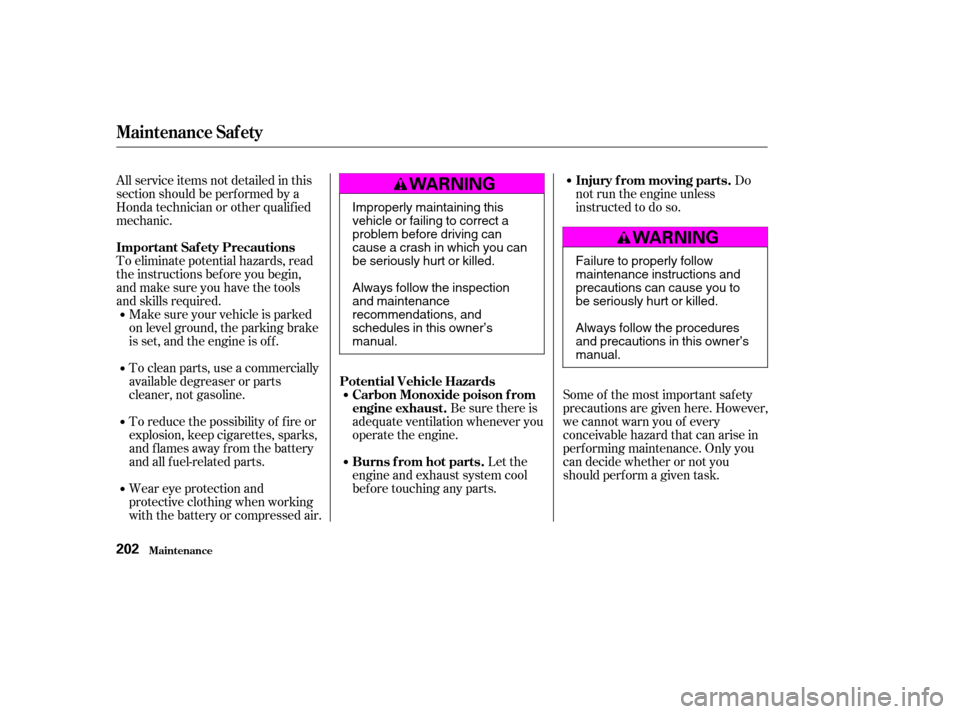Page 166 of 313

Lif t the hood up most of the way.
The hydraulic supports will lif t it
uptherestof thewayandholditup.
Lower the hood to about a f oot (30
cm) above the f ender, then press
down firmly with your hands. Make
sure it is securely latched.
Pull the support rod out of its clip
by holding the grip and insert the
end into the hole on the f ront of
the hood around the center.
Lif t it up slightly to remove the
support rod f rom the hole. Put the
support rod back into its holding
clip. Lower the hood to about a
f oot (30 cm) above the f ender,
then let it drop. Make sure it is
securely latched.
Reach in between the hood and
the f ront grille with your f inger.
The hood latch handle is above
and to the lef t of the ‘‘H’’ logo.
Push this handle up until it
releases the hood. Lif t the hood.
If the hood latch handle moves
stif f ly, or if you can open the hood
without lifting the handle, the
mechanism should be cleaned and
lubricated (see page ).
3.
2.
232
6-cylinder modelsTo Close the Hood:
To Close the Hood:
4-cylinder models
Service Station Procedures
Bef ore Driving167
GRIP
CLIP
4-cylinder models 6-cylinder models
LATCH
�����—�����—�����y�
�������������y���
�(���%���
���y���
�����y
Page 167 of 313
Wait a f ew minutes af ter turning the
engine of f bef ore you check the oil.Remove the dipstick (orange
handle/loop). Wipe of f the dipstick with a clean
cloth or paper towel.
Insert it all the way back in its hole.
Remove the dipstick again and
check the level. It should be
between the upper and lower
marks.
If it is near or below the lower mark,
see on page .
1. 2. 3.4.
217
Service Station Procedures
Bef ore Driving
Oil Check
A dding Oil
168
DIPSTICK
(Orange Handle)DIPSTICK
(Orange Loop)UPPER MARK
LOWER MARK
4-cylinder models 6-cylinder models 4-cylinder models
�����—�����—�����y�
�������������y���
�(���%���
���y���
���
�y
Page 168 of 313
Look at the coolant level in the
radiator reserve tank. Make sure it is
between the MAX and MIN lines. If
it is below the MIN line, seeon page f or
inf ormation on adding the proper
coolant. Refer to
on page f or inf ormation
on checking other items in your
Honda.
221 204
Service Station Procedures
Bef ore Driving
Engine Coolant Check
A dding
Engine Coolant Owner’s Maintenance
Checks
169
UPPER MARK
LOWER MARK RESERVE TANK
4-cylinder models MIN
MAX MAX
RESERVE TANK
6-cylinder models MIN
6-cylinder models
�����—�����—�����y�
������
������y���
�(���%���
���y���
�����y
Page 196 of 313

Many states and Canadian provinces
require special outside mirrors when
towing a trailer. Even if they don’t,
you should install special mirrors if
you cannot clearly see behind you, or
if the trailer creates a blind spot.
Askyourtrailersalesorrental
agency if any other items are
recommended or required f or your
towing situation.When preparing to tow, and bef ore
driving away, be sure to check the
f ollowing:
The vehicle has been properly
serviced, and the tires, brakes,
suspension, and cooling system
are in good operating condition.
All weights and loads are within
limits (see pages and ).
Thehitch,safetychains,andany
other attachments are secure.
Allitemsonandinthetrailerare
properly secured and cannot shif t
while you drive.
The lights and brakes on your
vehicle and the trailer are working
properly. Your vehicle tires and spare are
properly inf lated (see page ),
and the trailer tires and spare are
inflated as recommended by the
trailer maker.
194 195 285
Towing a Trailer
Driving
Additional Trailer EquipmentPre-T ow Checklist
197
�����—�����—�����y�
�������������y���
�(���%���
���y���������y
Page 200 of 313

This section explains why it is
important to keep your vehicle well
maintained and how to f ollow basic
maintenance saf ety precautions.
This section also includes
Maintenance Schedules f or normal
driving and severe driving conditions,
a Maintenance Record, and instruc-
tions f or simple maintenance tasks
you may want to take care of
yourself .
If you have the skills and tools to per-
f orm more complex maintenance
tasks on your Honda, you may want
to purchase the Service Manual. See
page f or inf ormation on how to
obtain a copy, or see your Honda
dealer.......................
Maintenance Saf ety . 202
.................
Maintenance Schedule . 203
Maintenance Schedule
..................
(4-cylinder Models) . 205
....................
Maintenance Record . 207
Maintenance Schedule
..................
(6-cylinder Models) . 210
....................
Maintenance Record . 212
..............................
Fluid Locations . 215
........................
Adding Engine Oil . 217
.........
Changing the Oil and Filter . 218
..............................
Engine Coolant . 221
....................
Windshield Washers . 224
.......................
Transmission Fluid . 225
..........
Automatic Transmission . 225
5-speed Manual
.........................
Transmission . 228
6-speed Manual .........................
Transmission . 228
................
Brake and Clutch Fluid . 230
....................
Power Steering Fluid . 231
....................................
Timing Belt . 232
....................................
Hood Latch . 232
.............................................
Lights . 233
.......................................
Seat Belts . 240
.....................................
Floor Mats . 240 ..................
Dust and Pollen Filter . 242
.................................
Wiper Blades . 243
...............................................
Tires . 245
........................
Check the Battery . 252
.............................
Vehicle Storage . 254
303
Maintenance
Maint enance201
�����—�����—�����y�
�������������y���
�(���%���
���y���������y
Page 201 of 313

All service items not detailed in this
section should be perf ormed by a
Honda technician or other qualif ied
mechanic.
To eliminate potential hazards, read
the instructions bef ore you begin,
and make sure you have the tools
and skills required.To clean parts, use a commercially
available degreaser or parts
cleaner, not gasoline. Be sure there is
adequate ventilation whenever you
operate the engine.
Let the
engine and exhaust system cool
bef ore touching any parts. Do
not run the engine unless
instructed to do so.
Some of the most important saf ety
precautions are given here. However,
we cannot warn you of every
conceivable hazard that can arise in
perf orming maintenance. Only you
can decide whether or not you
should perf orm a given task.
Make sure your vehicle is parked
on level ground, the parking brake
is set, and the engine is of f .
To reduce the possibility of f ire or
explosion, keep cigarettes, sparks,
and f lames away f rom the battery
and all f uel-related parts.
Wear eye protection and
protective clothing when working
with the battery or compressed air.
Maintenance Saf ety
Maint enance
Important Saf ety Precautions
Potential Vehicle HazardsCarbon Monoxide poison f rom
engine exhaust.
Burns f rom hot parts. Injury f rom moving parts.
202
Improperly maintaining this
vehicle or failing to correct a
problem before driving can
cause a crash in which you can
be seriously hurt or killed.
Always follow the inspection
and maintenance
recommendations, and
schedules in this owner’smanual.
Failure to properly follow
maintenance instructions and
precautions can cause you to
be seriously hurt or killed.
Always follow the procedures
and precautions in this owner’smanual.
�����—�����—�����y�
�������������y���
�(���%���
���y���������y
Page 202 of 313

�µ�µ
The maintenance schedule assumes
you will use your vehicle as normal
transportation for passengers and
their possessions. You should also
f ollow these recommendations:
Avoid exceeding your vehicle’s
load limit. This puts excess stress
on the engine, brakes, and many
other vehicle parts. The load limit
is shown on the tire inf ormation
label on the driver’s doorjamb.
Operate your vehicle on
reasonable roads within legal
speed limits. Service your vehicle according to the
time and mileage periods on one of
the Maintenance Schedules on the
f ollowing pages.
Follow the
Maintenance Schedule f or Severe
Conditions if you drive your vehicle
MAINLY under one or more of the
f ollowing conditions.
Driving less than 5 miles (8 km)
per trip or, in f reezing
temperatures, driving less than 10
miles (16 km) per trip.
Driving in extremely hot [over
90°F (32°C)] conditions. Trailer towing, driving with a roof
rack, or driving in mountainous
conditions.
Driving on muddy, dusty, or de-
iced roads.
If you only OCCASIONALLY
drive under a ‘‘severe’’ condition, you
should f ollow the Maintenance
Schedule f or Normal Conditions.
Follow the
Maintenance Schedule f or Severe
Conditions.
Drive your vehicle regularly over a
distance of several miles
(kilometers).
Always use unleaded gasoline with
theproperoctanerating(seepage ). Extensive idling or long periods of
stop and go driving, such as a taxi
or a commercial delivery vehicle.
164
Maintenance Schedule
Maint enance
Which Schedule to Follow:
U.S. Owners
Canadian Owners
203
NOTE:
�����—�����—�����y�
�������������y���
�(���%���
���y���������y
Page 203 of 313

�Ì�µ�µ
�µ
�µ
�µ
�µ
Your authorized Honda dealer
knows your vehicle best and can
provide competent, ef f icient service.
However, service at a dealer is not
mandatory to keep your warranties
in effect. Maintenance may be done
by any qualif ied service f acility or
skilled person to keep your
warranties in ef f ect. Keep all the
receipts as proof of completion, and
have the person who does the work
f ill out the Maintenance Record.
Check your warranty booklet f or
more inf ormation.
We recommend the use of Honda
parts and f luids whenever you have
maintenance done.
According to state and federal
regulations, f ailure to perf orm
maintenance on the items marked
with will not void your emissions
warranties. However, Honda
recommends that all maintenance
services be perf ormed at the
recommended time or mileage
period to ensure long-term reliability.Youshouldcheckthefollowing
items at the specif ied intervals. If
you are unsure of how to perf orm
any check, turn to the appropriate
page listed.
Lights Check the operation of
the headlights, parking lights,
taillights, high-mount brake light,
and license plate lights monthly.
See page .
Engine oil level Check every
time you fill the fuel tank. See
page .
Engine coolant level Check the
radiator reserve tank every time
you f ill the f uel tank. See page .
Automatic transmission Check
the f luid level monthly. See page
.
Brakes Check the f luid level
monthly. See page .
Tires Check the tire pressure
monthly. Examine the tread f or
wear and foreign objects. See page .
U.S. Vehicles:
233
168
169
225 230
245
Maintenance Schedule
Maint enance
Servicing Your Vehicle Owner’s Maintenance Checks
Maintenance,
replacement, or repair of
emissions control devices and
systems may be done by any
automotive repair establishment
or individual using parts that are
‘‘certif ied’’ to EPA standards.
204
�����—�����—�����y�
�������������y���
�(���%���
���y���������y